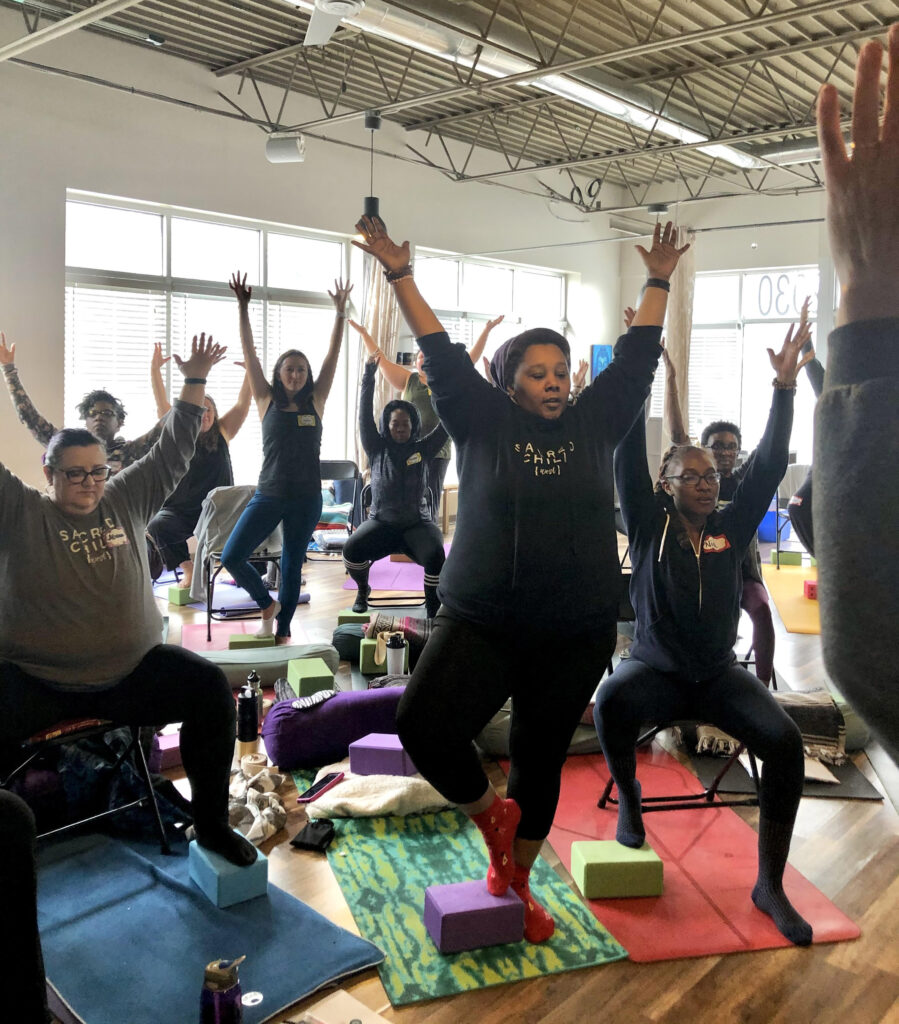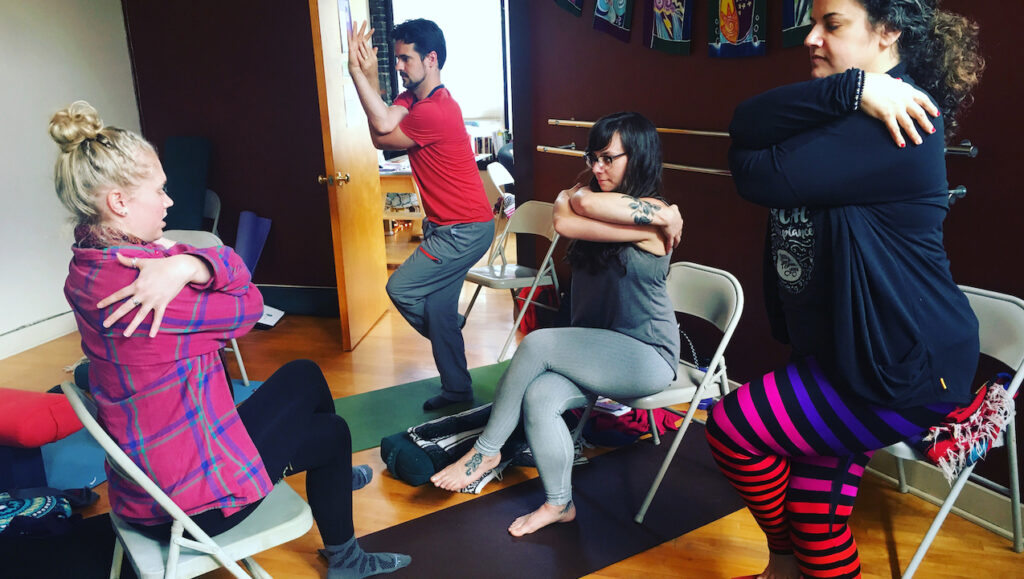Sometimes, in our quest to do things “the right way,” we get so caught up in how we look that we forget why we even stepped on the yoga mat in the first place. We get into the habit of performing and doing, and we forget to practice being and becoming. Unfortunately, this attitude can catch up with us and not only cause injury to our physical bodies, but also drive us further away from ourselves and others.
Recently I have become aware of a special movement happening inside the yoga community. Although this concept has been around for many years, it is not yet mainstream in America. I am excited to share with you that this is shifting. A group of teachers and students are changing the way yoga is taught and practiced in the West. If you have taken a class with me during the past month or so, you have heard my language and approach to teaching yoga shift and change.
Accessible Yoga Movement
What am I referring to? I am sharing Jivana Heyman’s passion and mission to make yoga accessible to all. Jivana founded a nonprofit organization called Accessible Yoga. He has written a few books that address accessibility and offer possibilities and practices for every body. In his recent book, Yoga Revolution: Building a Practice of Courage & Compassion, Jivana invites all of us to join the yoga revolution and live life with a heart and mind that accepts differences and rejects injustice and oppression.
Like others, I am committed to offering classes that are accessible and creating an environment where people of all ages and abilities can show up and be themselves, move their body in a way that feels good, and engage in service and social justice.

When we expand our heart and mind in this way, we practice courage to walk alongside someone and turn toward truth, love, and compassion. Yoga truly is a practice of unity and equality.
Mission & Vision
Accessible Yoga believes that all people—regardless of ability or background—deserve equal access to yoga. Through education and advocacy, we share the teachings and benefits of yoga with those who have been marginalized.
We envision a world where everyone has access to the yoga teachings that offer individual empowerment and spiritual awakening. We identify and remove barriers to access, build strong networks, and advocate for an accessible, equitable, and dynamic yoga culture.
My Accessible Yoga Teacher Training Experience
At the beginning of this year, I made a commitment to learn more about this organization. I registered for the January 2022 Accessible Yoga Teacher Training. This 35-hour online course offered me an opportunity to learn how to design yoga classes where all students can practice together regardless of age, size, ability, or experience level.
We covered many topics such as teaching in the online space, integrating chair and mat classes into one mixed-level asana practice, and integrating yoga philosophy and making it more accessible, safe, and enjoyable, with attention to trauma-informed teaching. We also learned how to determine safe and appropriate variations to common asanas for a range of physical abilities, understood the purpose and implementation of props, and acquired additional knowledge of common medical conditions as it relates to benefits and concerns for implementation of a yoga practice.
We were introduced to some amazing guest instructors. Many of these teachers are also authors, business owners, and advocates for accessible yoga. These guest instructors and topics included:
- Susanna Barkataki on Honoring the Roots of Yoga
- Amber Karnes on Working with Larger Bodies
- Anjali Rao on Yoga & Activism
- Kelley Palmer on Race & Equity
- M Camellia on Agency and Consent
Even after teaching yoga for more than 20 years, I found this training to be a very valuable experience. I have been introduced to some amazing teachers and rediscovered ways to bring students together and practice these ancient teachings in a safe and united way.
I also feel very included in this community. It is an organization I want to belong to and support. In other words, I have found my people!
What Does Accessible Yoga Look Like?
The teacher will use language and offer possibilities to people of all abilities. Props will be offered and included in the instructions. Yoga philosophy, meditation, breath work, and movement will be included and incorporated into the yoga class. The focus will shift from how you look on the outside to how you feel on the inside.

As a student, you will be reminded that yoga is an inclusive and equitable practice that is safe and effective and still respectful of the Indian roots. You do not need a body that is flexible to do yoga. Your yoga practice will be personalized to your body and your needs at that present moment.
Jivana shares, “Yoga reminds us that we’re not just the body-mind: we are eternal. Yoga asks us to identify with our unchanging essence, our spirit, rather than with the constantly changing body and mind…We are invited to release a judgmental attitude that certain bodies are superior to others and that one way of being in a body is better than other ways. When we can practice this shift, we can connect more directly to the goals of the practice.”
What Does Yoga have to do with Social Justice?
An additional aspect of the accessible yoga community is remembering that the work we do on ourselves has a direct correlation to the way we affect the world around us. We can build courage and compassion through our practice and move out into the world with an open heart. Our personal practice is a microcosm for the way we exist in the world and allows us to engage in a more conscious way. Yoga is love in action.
Engaging in social justice doesn’t mean you need to get involved with every movement or be an expert. It can show up in our day-to-day lives in the way we talk to our children, the way we vote, and the ways we support our community. Service is really about seeing ourselves in others and acting from a place of love and compassion. It is how we practice yoga off the mat.
Is Yoga Really for Me?
If you have ever doubted yourself and thought you could not do yoga because you were too stiff, too fat, too old, too black, too “whatever,” I hope this message finds its way into your heart. Yoga is for everyone and every body. If you have a body and you can breathe – you can do yoga. Yoga is a sanctuary of healing and a practice that will support your work in the world.
Join me and the Resilience & Grace kula. Practice yoga in a community that is accessible and welcoming. There are many class options to choose from (mixed-level, gentle, chair, restorative, yin, and strength and balance fitness) and an on-demand video library you can access anytime, anywhere. Schedule a 20-minute consultation with me and learn about which class(es) may be right for you. New students also receive a “first class free” coupon to make it easy to give yoga a try.
Om Shanti, Shanti, Shanti (peace)
The images used in this article are from Accessible Yoga School, used with permission.

